The magnificence of Russia's Baroque churches
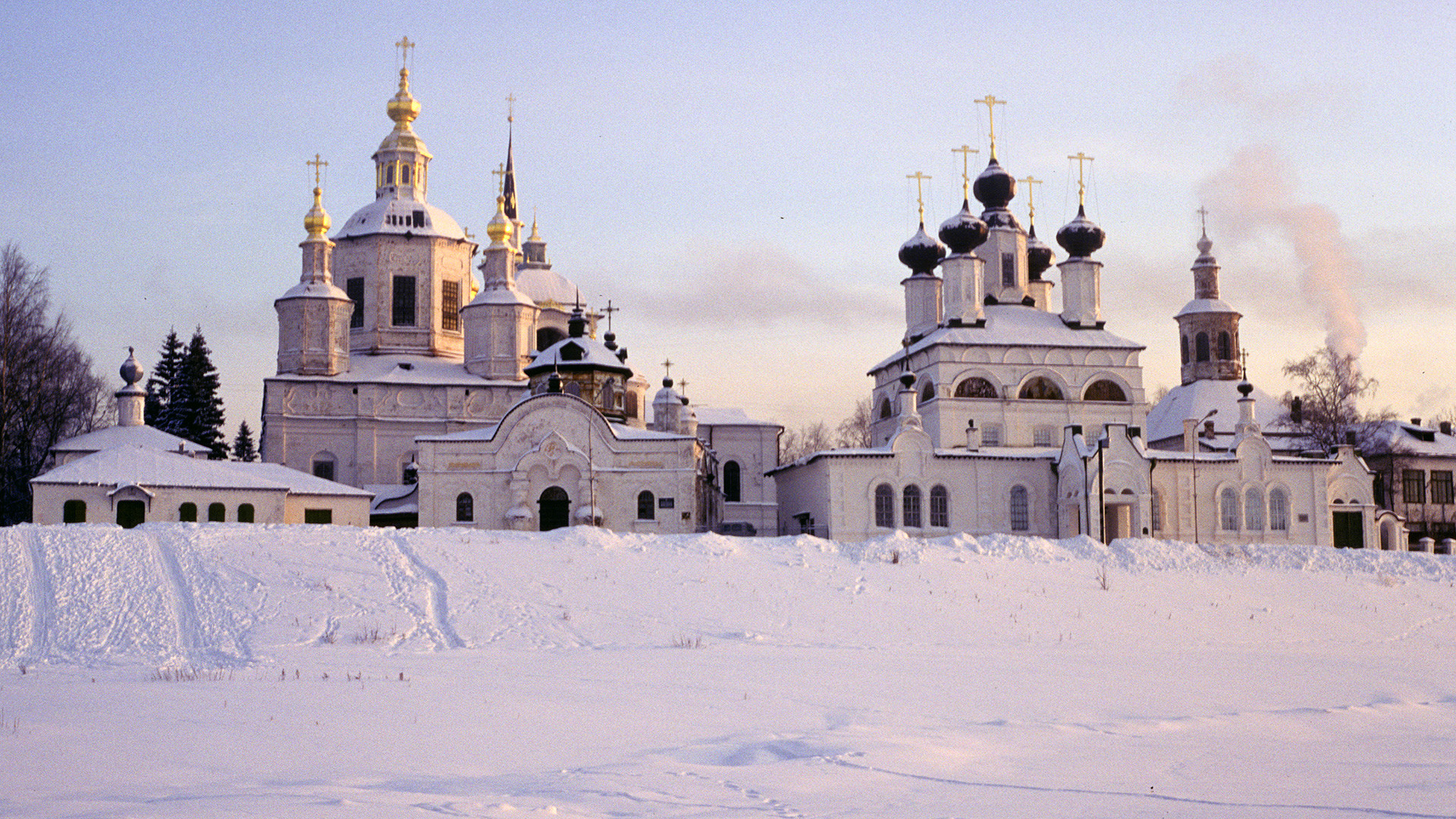
Veliky Ustyug. Cathedral ensemble from frozen Sukhona River. January 6, 1997
William BrumfieldSmolensk, on Russia’s western borderlands near Poland, is one of the country’s ancient cultural centers. In summer 1911, Russian chemist and photographer Sergey Prokudin-Gorsky visited Smolensk to document sites connected with the 1812 Napoleonic invasion.
The presiding visual motif of Smolensk is the monumental Cathedral of the Dormition of the Virgin, situated on a hill in the center of the city. In the early 17th century, the Dormition Cathedral was severely damaged in a Polish siege during the catastrophic dynastic crisis known as the Time of Troubles. After the return of Smolensk to Muscovite control in 1654, a rebuilding of the Dormition Cathedral began on the same site. Construction challenges extended the project for decades until completion of the interior in 1772.
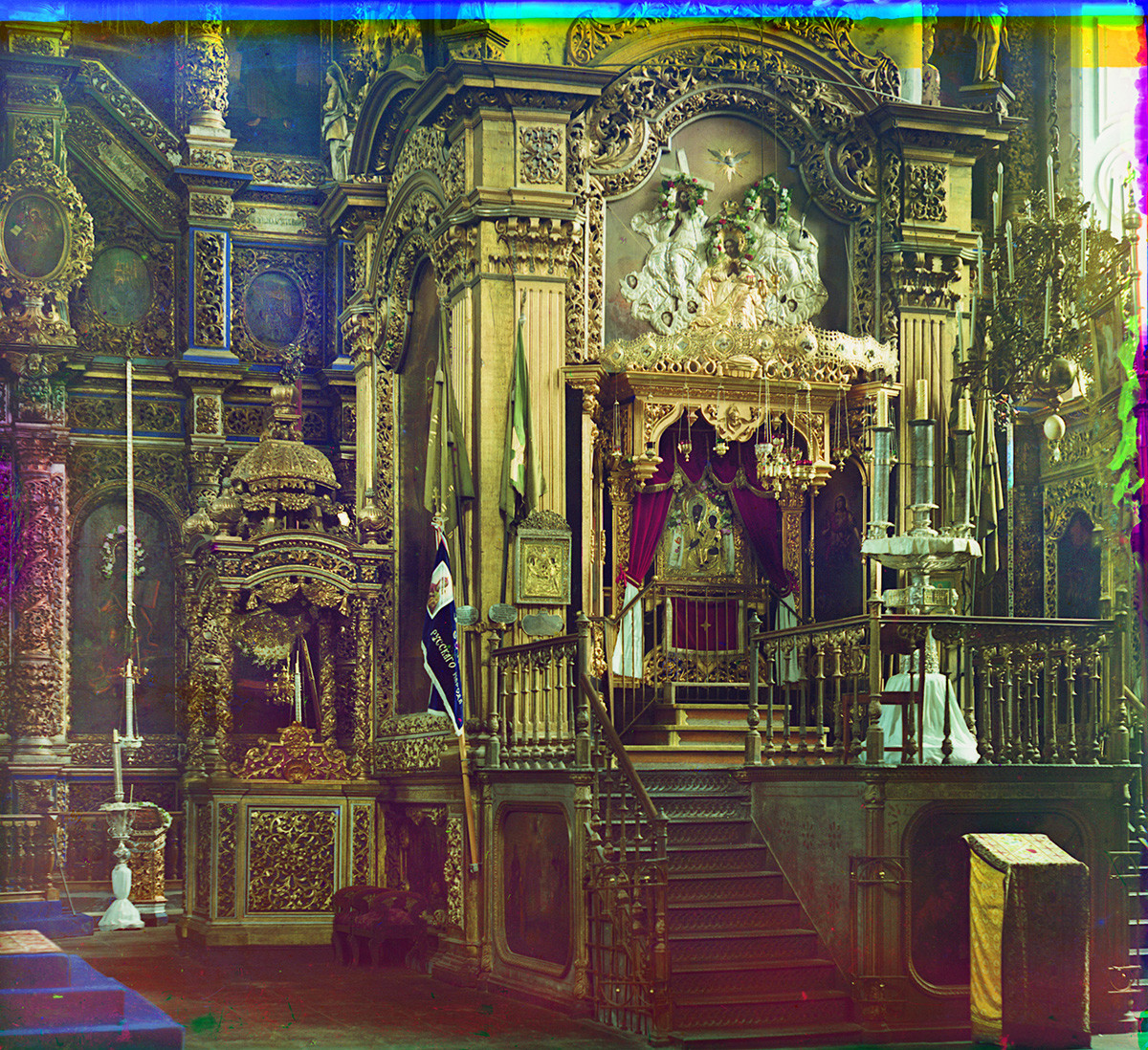
Smolensk. Dormition Cathedral, interior, view of baldachin with Smolensk Icon. Summer 1911
Sergey Prokudin-GorskyThe main work, however, was done in the 1730s and 1740s, when the cathedral acquired its present form, strongly influenced by the Ukrainian Baroque. The baroque style is particularly evident on the interior with a magnificent icon screen, whose carved, glided frame and tiers of icons were created by a group of artists and craftsmen headed by the Ukrainian master Sila Trusitsky. The interior was further enhanced by the creation in 1743-46 of elaborately carved baldachins and icon cases (kiot) situated near the icon screen and at the base of the cathedral’s mighty piers.

Smolensk. Dormition Cathedral, view of icon screen & baldachin with copy of Smolensk Icon. July 1, 2014
William BrumfieldProkudin-Gorsky recorded the cathedral exterior as well as the interior, where he photographed its sacred shrine — the Smolensk Icon of the Mother of God. That photograph has acquired exceptional importance, not only because of its technical challenges (a shadowed interior with only natural light) but also because the icon disappeared at some point during the two years of German occupation during World War II, from mid-July 1941 to late September 1943.
A portion of the first tier of the magnificent icon screen is visible in the background of Prokudin-Gorsky’s photograph. My photographs, taken in 2006 and 2014, convey a sense of the grand scale of the iconostasis.
A northern interpretation of a European style
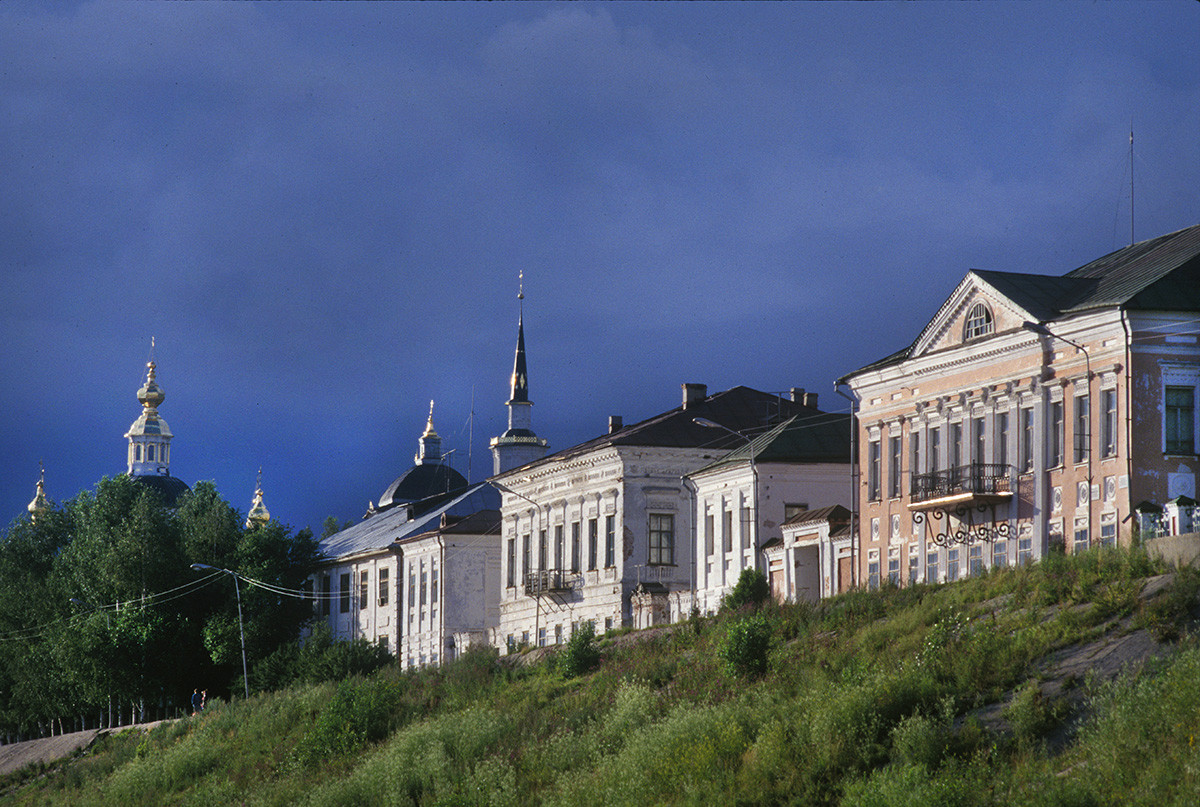
Veliky Ustyug. Sukhona River embankment with former houses of wealthy merchants. Right: mansion of Grigory Usov (late 18th c.). July 26, 1996
William BrumfieldSmolensk is not the only Russian town with distinctive examples of the 18th-century baroque. Nowhere is this culture better preserved than in the town of Veliky Ustyug (Great Ustyug) in the Russian North. Located on the left bank of the Sukhona River, the town combines a rich ensemble of historic architecture with a natural setting of remarkable beauty.
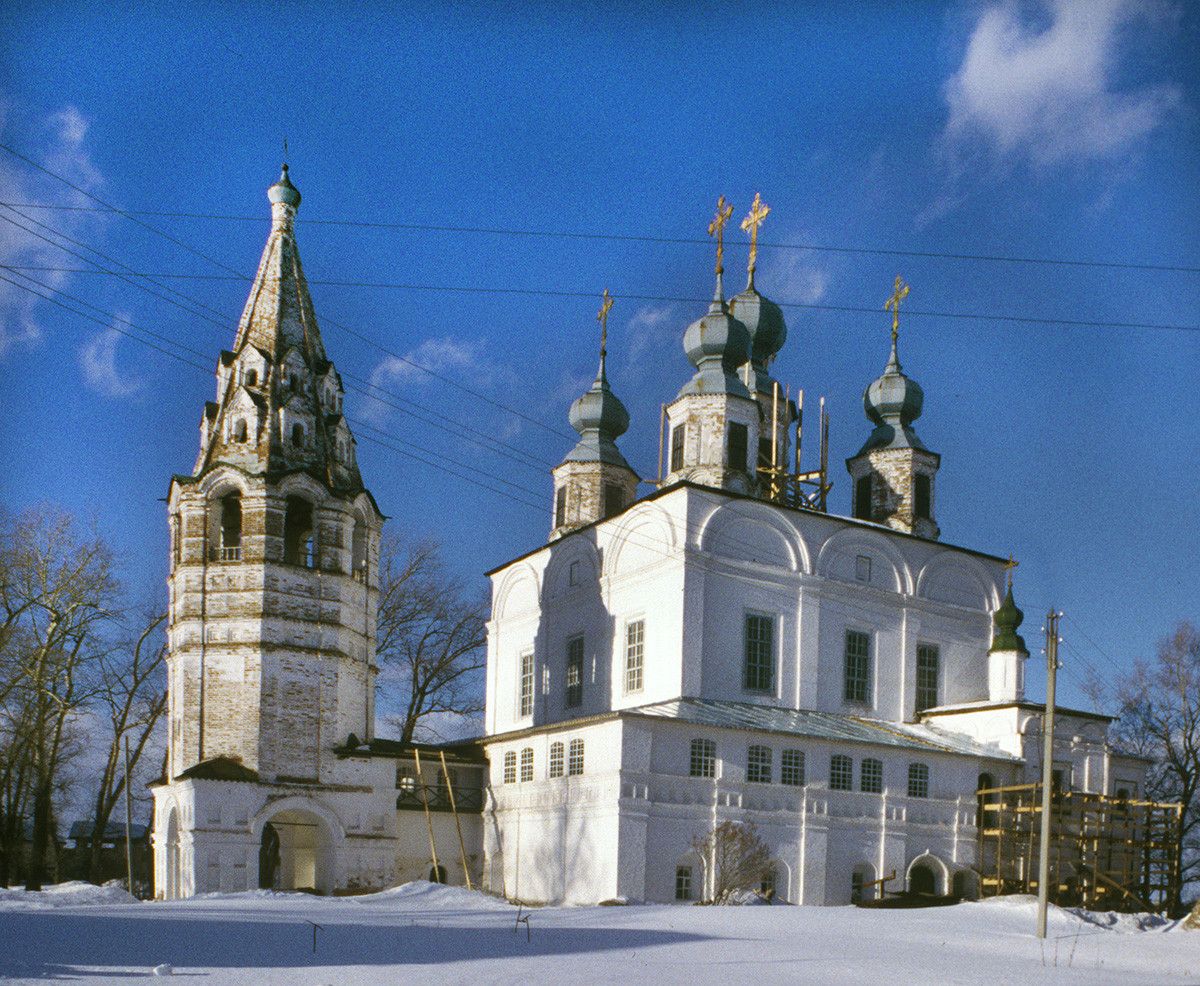
Trinity-Gleden Monastery (Veliky Ustyug). Bell tower & Trinity Cathedral, southwest view. March 7, 1998
William BrumfieldJust across the river is the Trinity-Gleden Monastery, whose main church contains an enormous icon screen that is one of the great works of baroque religious art in Russia. Statues of angels, putti and divine figures hover around elaborately carved frames for dozens of icons painted in the style of the Italian Renaissance.
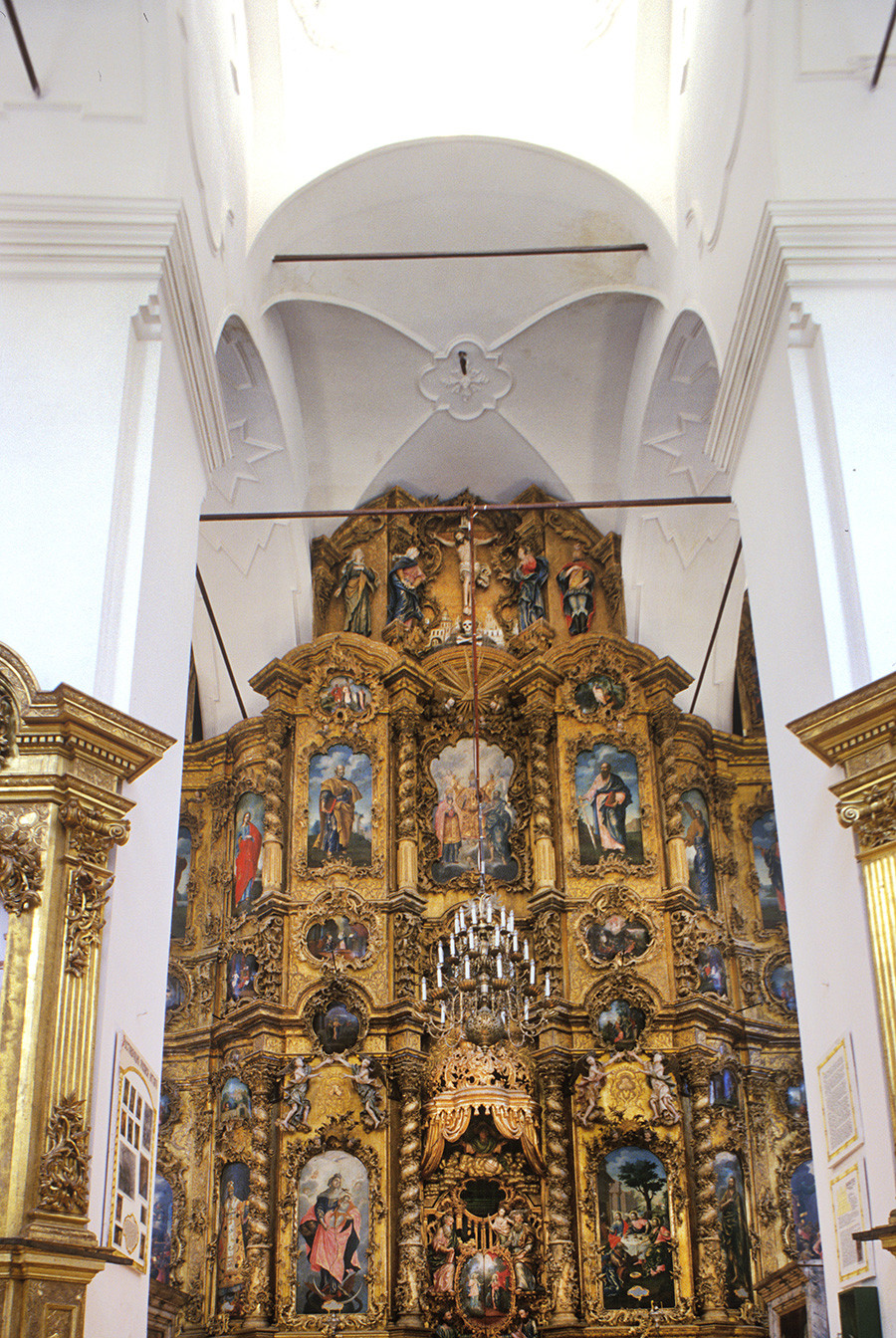
Trinity-Gleden Monastery. Trinity Cathedral, view east toward icon screen. July 18, 1999
William BrumfieldThis miraculous display originated in the wealth of local merchants who made substantial donations to Ustyug’s monasteries. Although the development of St. Petersburg in the 18th century lessened Ustyug’s significance in transportation and trade, the town continued to prosper as a regional mercantile center. Ustyug was also highly regarded for crafts such as leather and metal working, as well as the production of fine enamel objects.
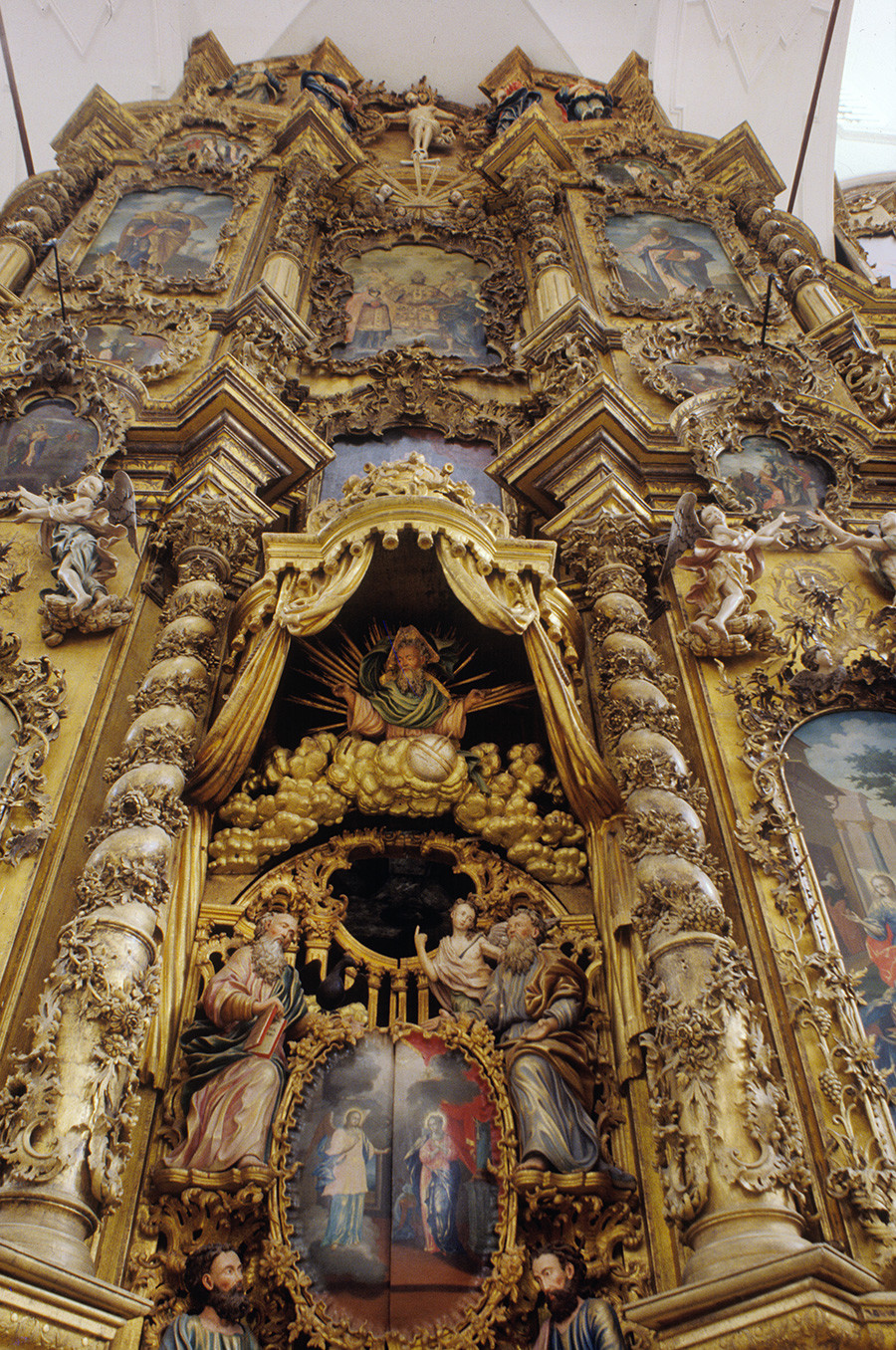
Trinity-Gleden Monastery. Trinity Cathedral icon screen. Center: Royal Gate (entrance to altar space). Top: wooden statue of Christ on the Cross. July 27, 1996
William BrumfieldIts silversmiths in particular developed specialized skills in the niello technique, and their work was in demand not only in the north but also in St. Petersburg, including at the imperial court. These commercial ties led to a familiarity with the lavish decorative forms of 18th-century religious art. As a result, Ustyug’s major monastery churches had gilded icon screens that display a northern interpretation of the European baroque style.
Sublime example of the baroque
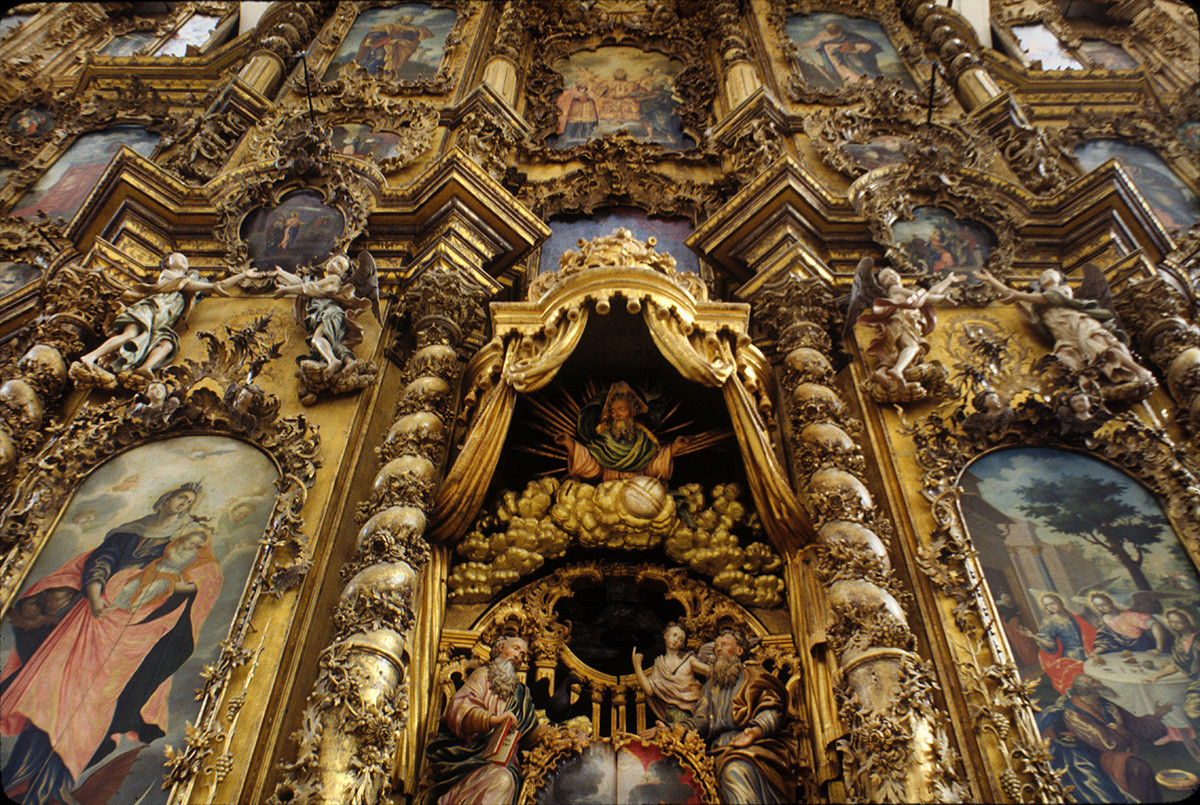
Trinity-Gleden Monastery. Trinity Cathedral icon screen. Royal Gate flanked by icons of Virgin Mary & Old Testament Trinity. July 27, 1996
William BrumfieldThe Trinity Monastery is situated some three miles to the southwest of Veliky Ustyug on the opposite, high bank of the Sukhona. Established at the ancient settlement of Gleden no later than the middle of the 13th century, the monastery consisted of wooden structures (including three log churches) for the first 400 years of its existence.
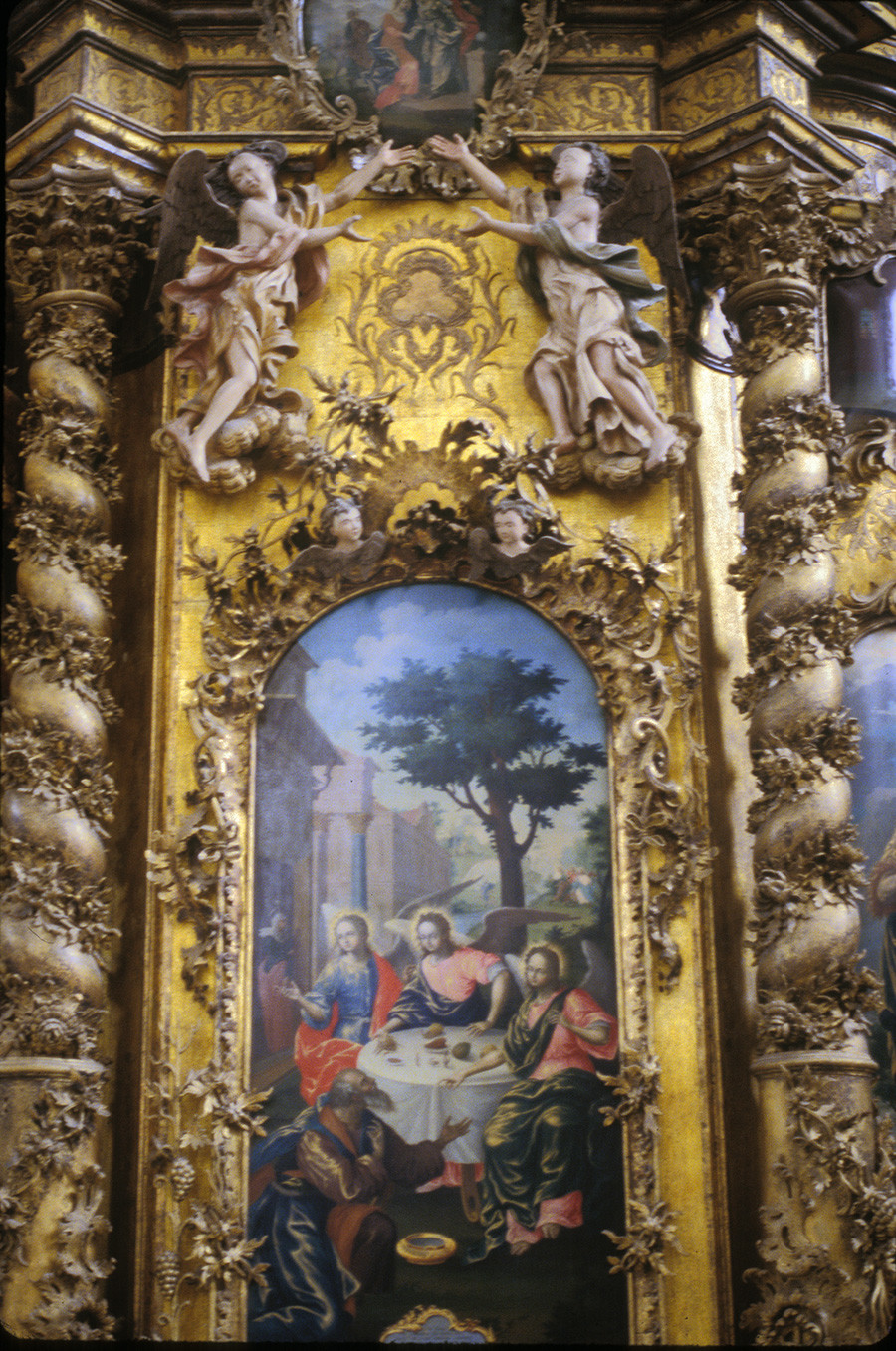
Trinity-Gleden Monastery. Trinity Cathedral icon screen. Icon of Old Testament Trinity (Three angels with Abraham & Sarah). July 27, 1996
William BrumfieldThe monastery’s earliest masonry structure was the rebuilt Trinity Cathedral, begun in 1659 with donations by Sila and Ivan Grudtsyn, who were among Ustyug's wealthiest merchant families. Financial and legal difficulties after the death of the brothers halted construction for much of the 1660s until 1690. The structure, with its five cupolas and a separate bell tower in the west, was finally completed at the end of the 17th century.
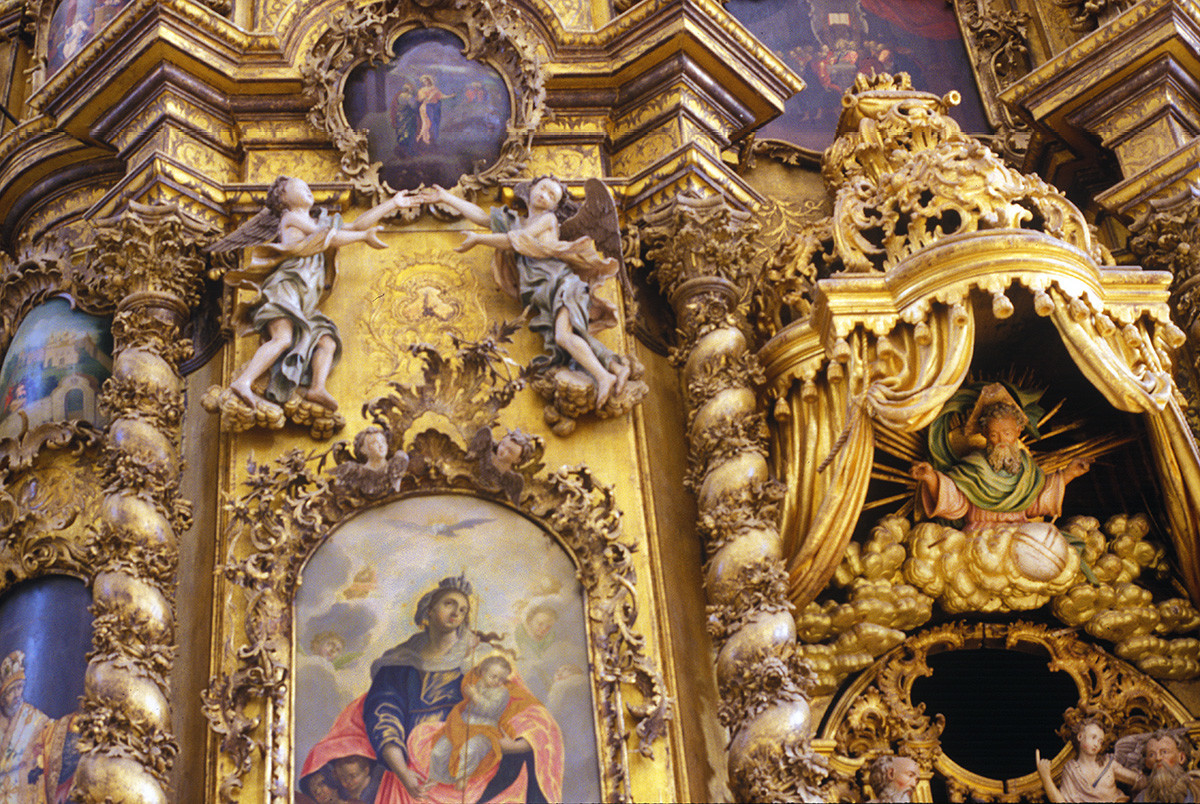
Trinity-Gleden Monastery. Trinity Cathedral icon screen. Royal Gate canopy with carved image of Lord God Sabaoth. Left: icon of Virgin Mary with Christ Child. July 23, 1998
William BrumfieldThe exterior is imposing, but without the elaborate façade ornaments typical of other 17th-century Russian churches. The appearance of the interior is also restrained, with no frescoes and only two massive piers (instead of the usual four) supporting the ceiling vaults and domes. This balanced structural design allows for greater natural illumination, which brings forth the carved baroque details of the cathedral’s enormous icon screen at the east end of the interior.
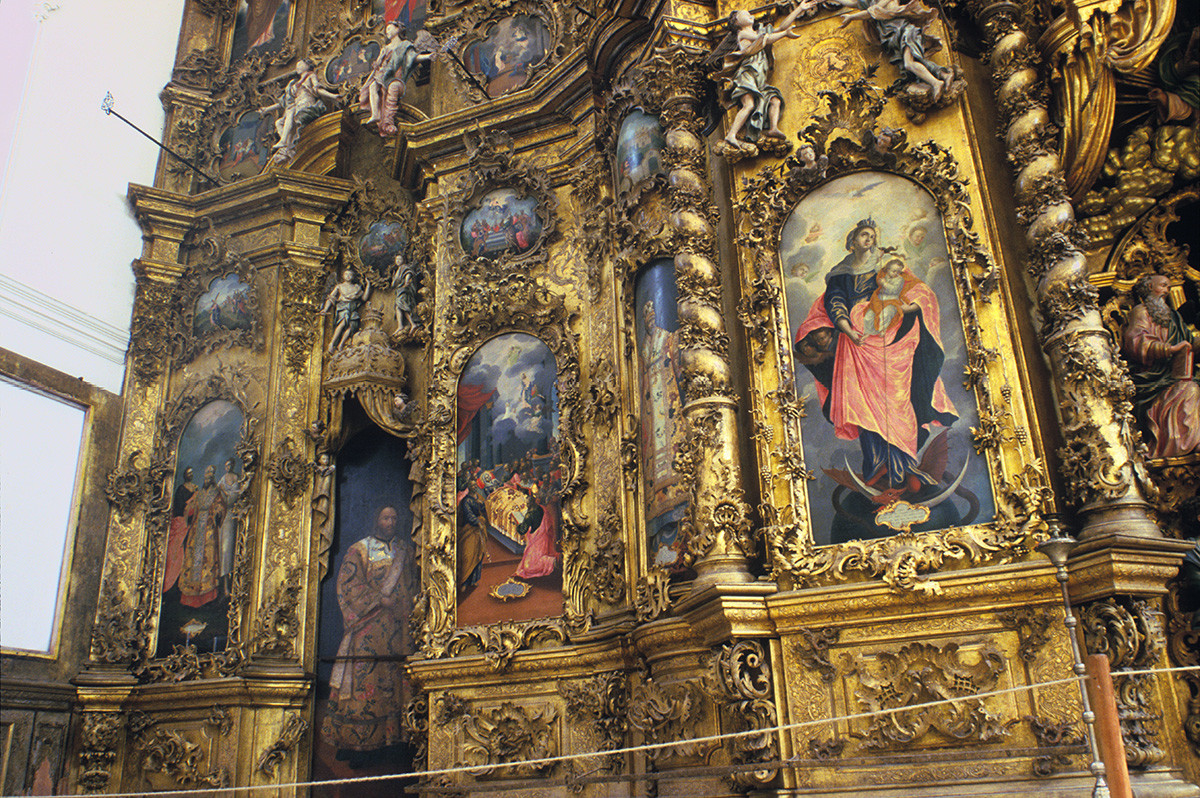
Trinity-Gleden Monastery. Trinity Cathedral icon screen. Left (north) segment with icons of Dormition of Mary (center), Virgin Mary with Christ Child. July 23, 1998
William BrumfieldThis magnificent creation, framed with five rows of intricately carved and gilded wood, took almost a decade to create, from 1776 to 1784. The soaring wooden structure conceals the altar space in the east and rises to a crescendo at its center, with flanking “wings” on either side. These three parts form a seamless whole, from north to south along the east side of the interior.
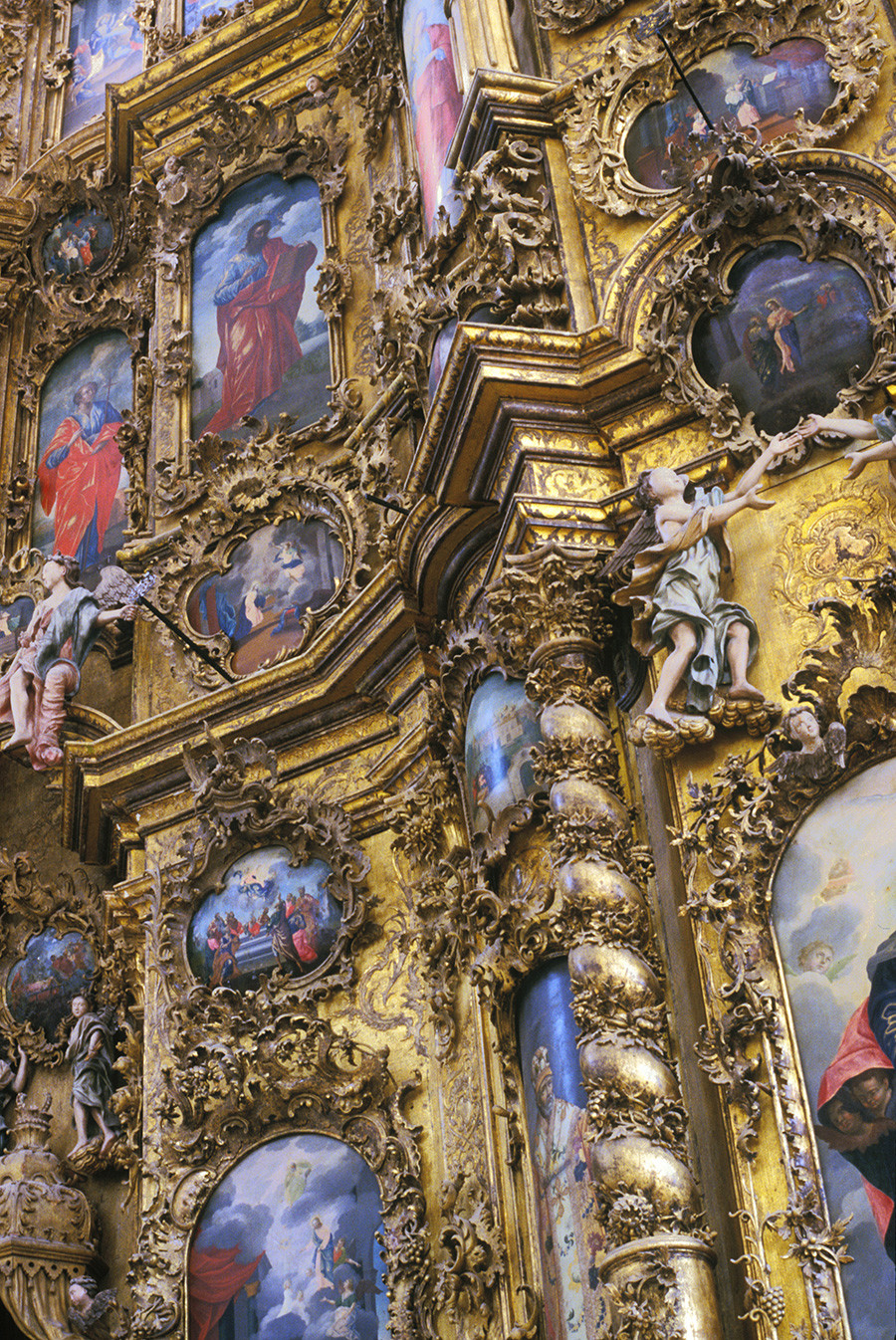
Trinity-Gleden Monastery. Trinity Cathedral icon screen. Left segment with icons on Festival & Deesis Rows. July 23, 1998
William BrumfieldThe masterful carving includes extensive statuary that amplifies the church's guiding motif, dedicated to the ministry and Passion of Christ. The style of the icon painting imitates that of Italian masters, particularly noticeable in depictions of the Virgin. To the right of the Royal Gate, which leads to the altar, is a large icon of the Old Testament Trinity, to which the monastery is dedicated.
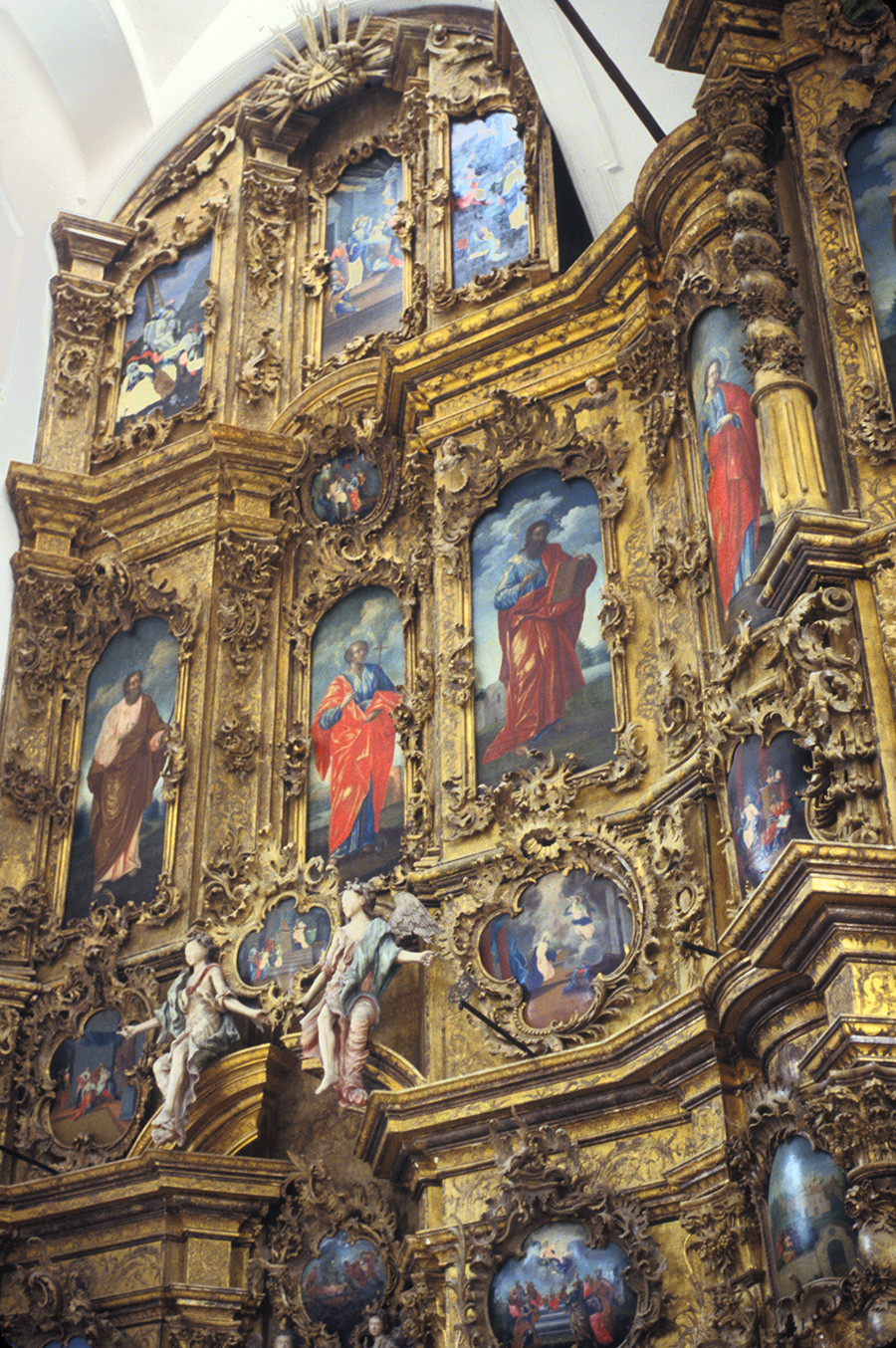
Trinity-Gleden Monastery. Trinity Cathedral icon screen. General view of left segment. July 27, 1996
William BrumfieldThe ultimate source for this combination of florid baroque and classical elements is St. Petersburg, yet numerous other 18th-century Russian churches displayed a similar style. For example, the town of Totma, located on the Sukhona River some 200 kilometers to the southwest of Veliky Ustyug, was known as a center of northern baroque.
Indeed, the contract for the icon screen at the Trinity Monastery identifies the primary master craftsmen as residents of Totma. But even Totma, whose baroque church interiors were barbarously ransacked during the Soviet era, had nothing to compare with the complexity of the iconostasis at the remote Trinity Gleden Monastery.
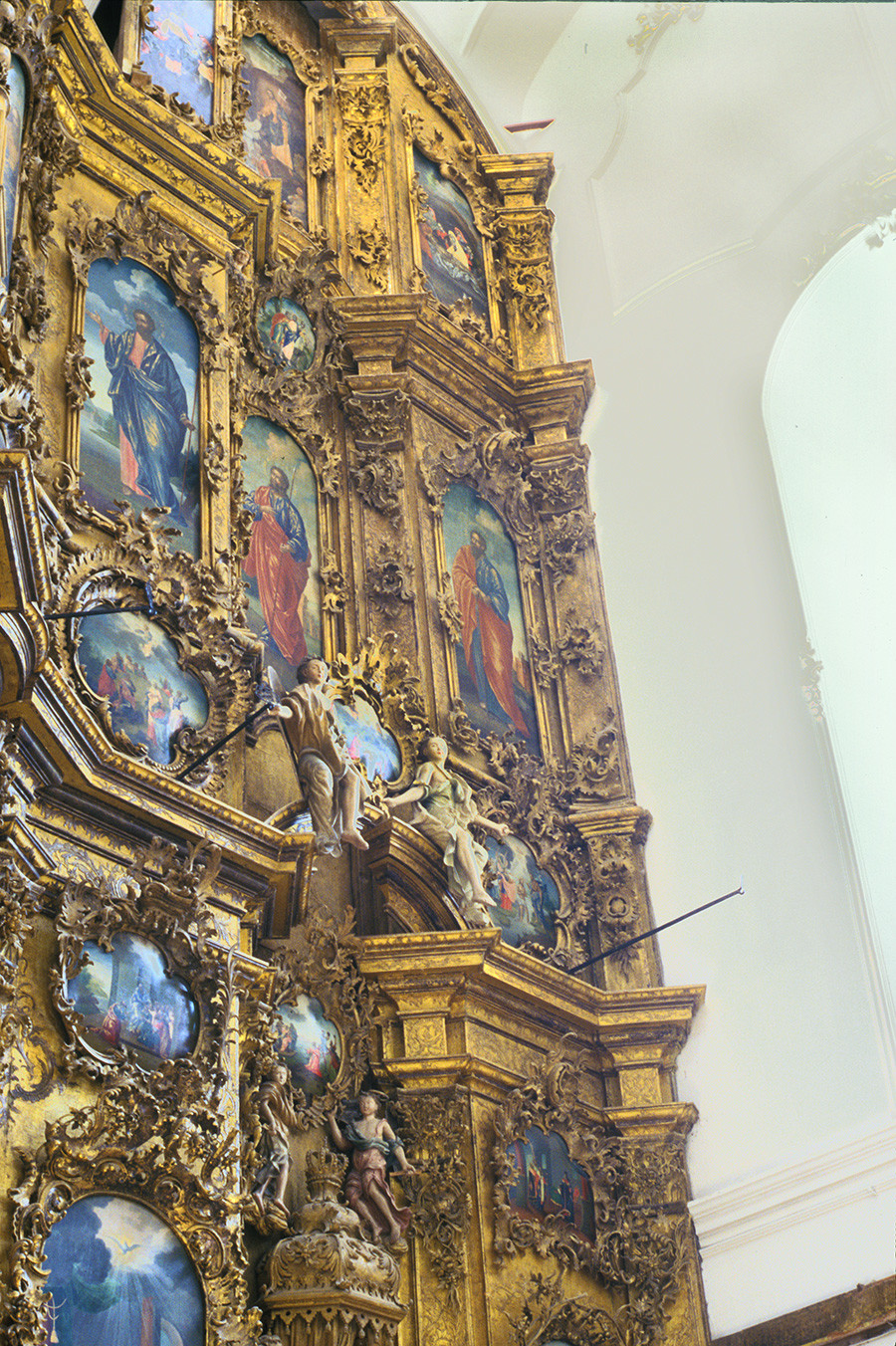
Trinity-Gleden Monastery. Trinity Cathedral icon screen. General view of right (south) segment. July 23, 1998
William BrumfieldWithin the Trinity Monastery's unfinished brick walls there are two other churches: the refectory and Church of the Presentation, completed in the 1740s; and the infirmary Church of the Dormition, built in the 1740s over the monastery’s west gate.
A miraculous survival
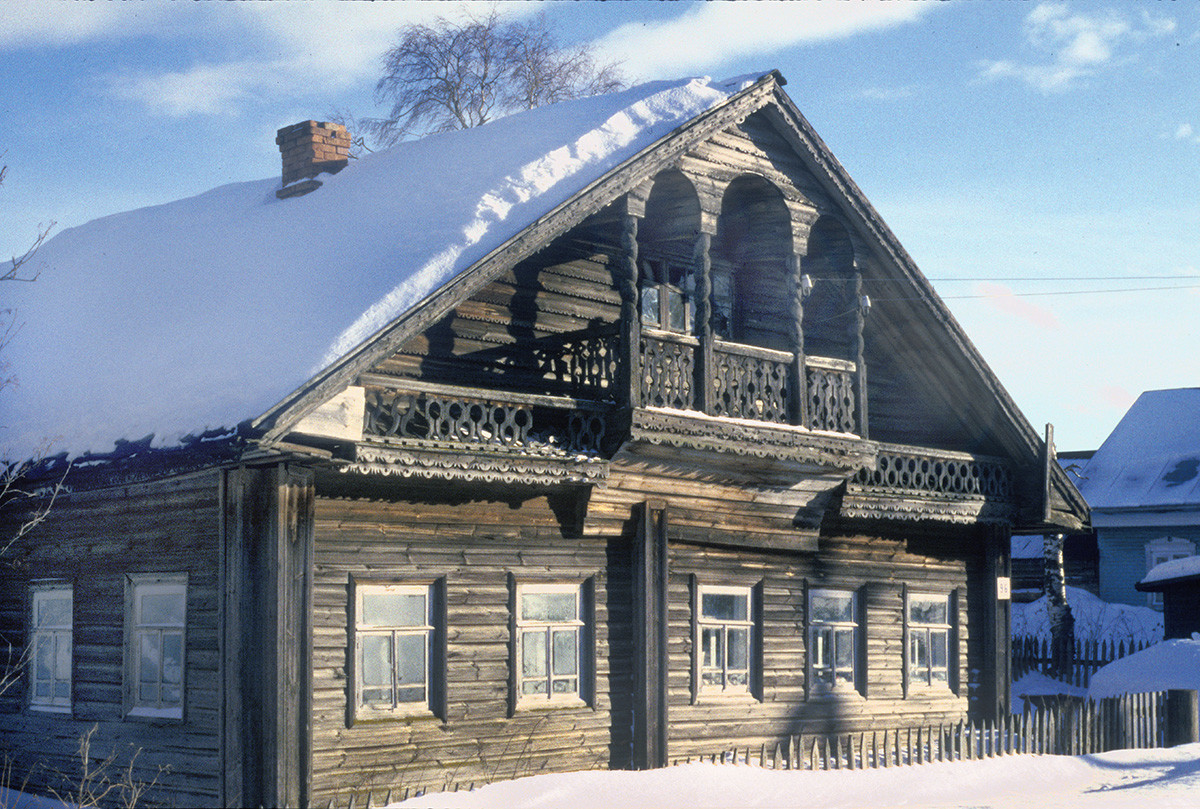
Morozovitsa (near Gleden). Wooden house with ornamental carving. (House has now been substantially modified.) March 7, 1998
William BrumfieldIn 1841, the small, secluded monastery with its unimaginably beautiful treasure was closed, only to be reopened in 1912 as a convent. After the Bolshevik Revolution, the nuns existed precariously as an agricultural commune until the convent was disbanded in 1925.
From that point the former monastery served various grim uses, including as a refuge for orphans and a detention center for juvenile delinquents. From the 1930s, it was also used to house exiled peasant families and indigent elderly. The interiors of the Churches of the Presentation and Dormition were completely vandalized, although their exteriors remained intact.
Throughout these cataclysms, the Trinity Cathedral remained locked and protected until the 1980s, when the entire ensemble was deeded to the excellent Veliky Ustyug museum. With limited resources, the dedicated museum staff has carefully preserved what time and fate have left. Thus, the magnificent baroque icon screen at the Trinity Gleden Monastery embodies two miracles — that of its creation and that of its improbable survival in the 20th century.
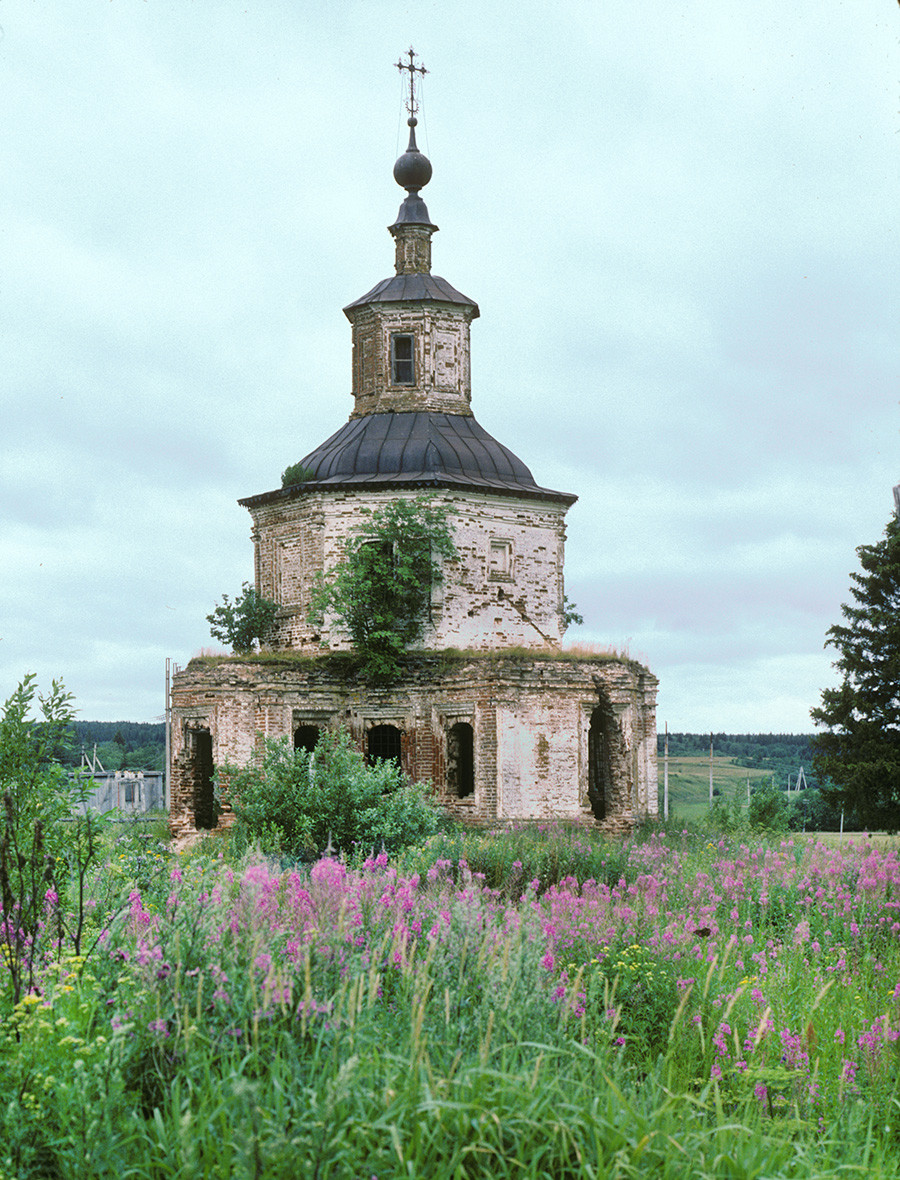
Gleden. Church of St. John of Ustyug at Pukhovo (Descent of the Holy Spirit). Built in 1764 by Trinity Monastery to commemorate the birth of St. John of Ustyug, the abandoned church collapsed in 1999. July 27, 1996
William BrumfieldIn the early 20th century, the Russian photographer Sergey Prokudin-Gorsky developed a complex process for color photography. Between 1903 and 1916 he traveled through the Russian Empire and took over 2,000 photographs with the process, which involved three exposures on a glass plate. In August 1918, he left Russia and ultimately resettled in France where he was reunited with a large part of his collection of glass negatives, as well as 13 albums of contact prints. After his death in Paris in 1944, his heirs sold the collection to the Library of Congress. In the early 21st century the Library digitized the Prokudin-Gorsky Collection and made it freely available to the global public. A few Russian websites now have versions of the collection. In 1986 the architectural historian and photographer William Brumfield organized the first exhibit of Prokudin-Gorsky photographs at the Library of Congress. Over a period of work in Russia beginning in 1970, Brumfield has photographed most of the sites visited by Prokudin-Gorsky. This series of articles juxtaposes Prokudin-Gorsky’s views of architectural monuments with photographs taken by Brumfield decades later.
If using any of Russia Beyond's content, partly or in full, always provide an active hyperlink to the original material.
Subscribe
to our newsletter!
Get the week's best stories straight to your inbox